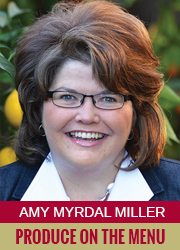 I have often written in this column that our words matter. How we talk about our businesses and our products matter. Many in the foodservice industry are grappling with the issue of how to describe their menus. What are the best words or phrases to describe “better-for-you” menu options that provide greater nutrition while still delivering on customers’ expectations for taste?
I have often written in this column that our words matter. How we talk about our businesses and our products matter. Many in the foodservice industry are grappling with the issue of how to describe their menus. What are the best words or phrases to describe “better-for-you” menu options that provide greater nutrition while still delivering on customers’ expectations for taste?
When you hear the phrase “plant-based,” what comes to mind? For many, this term conjures up images of vegetarian or vegan cuisine, which is appealing to some, appalling for others.
Conversely, when you hear “plant-forward,” what comes to mind? Do you visualize something similar or quite different? These are questions foodservice operators are asking themselves and their customers as they continue to evolve their menus to meet the needs and demands of today’s customer.
As director of The Culinary Institute of America (CIA) Healthy Menus R&D Collaborative — an innovative supplier-operator partnership focused on health and wellness imperatives, including increasing use of fruits and vegetables on menus — I am working with members of the Plant-Forward Working Group to define the difference between the two phrases.
The term “plant-based” grew out of research on traditional dietary patterns in specific regions of the world, like the Mediterranean. The traditional Mediterranean diet consists of abundant plant foods, including fruits, vegetables, legumes, whole grains, nuts and seeds with lesser amounts of dairy, meat, poultry and seafood. The research showing associations between this and similar dietary patterns and improved health outcomes led many in the nutrition and public health community to recommend these “plant-based” diets. But the devil is in the details, and while the intent was never to promote vegetarian or vegan diets, that’s the message some people heard and/or received.
Then some in the nutrition and culinary community started recommending “plant-forward” diets to illustrate how traditional dietary patterns emphasize plant foods and de-emphasize animal foods. But this didn’t end the confusion. Now people are starting to ask how much of the diet should be plants? How often should I eat dairy, meat, poultry or seafood? Do I need any?
Whether we call it “plant-based” or “plant-forward” may not really matter. We just need to get more produce on the plate.
When chefs are creating new menu options, they are wondering how many of the ingredients should be plant foods? Which plant foods? Are some better than others? Is fresh best? And so it goes.
A common phrase in the culinary nutrition community embracing plant-forward cooking is “make meat the condiment.” The analogy is how Vietnamese cooks use a few strips of pork on top of a steaming bowl of pho. You immediately see the pork…and then you start to notice the vegetables, herbs and broth that make up the majority of the dish.
Members of the CIA Healthy Menus R&D Collaborative (HMC) are wondering how far they have to go with plant-forward menus. Leaders in campus dining talk about the increasing demand for vegetarian and vegan fare, while leaders in other segments of the industry say those options are less important to their core customers. The typical burger and fries lover has no interest in a vegetarian burger. But is there a more plant-forward way of giving that burger lover what he/she wants in a more healthful yet still appealing way? That’s the challenge these foodservice leaders are addressing. How can we give our customers what they want in a “better-for-you” way that will sell?
Collectively, operator members of the CIA Healthy Menus R&D Collaborative serve more than 100 million meals every day in this country. Small changes in their menus can have a big impact on public health. What if they add 10 percent more fresh produce to their menus? Or 25 percent more produce as they continue to evolve their menus?
One concept an HMC leader tested years ago in a large chain restaurant was a slightly smaller burger (3-ounce versus 5-ounce patty) on a slightly smaller bun paired with a half portion of French fries and a small side salad. Sadly, the concept went into test market as the recession hit, and it failed miserably. Diners demanded value during the recession; a smaller burger didn’t match customer expectations.
That same leader is now working for another major foodservice operator. I’m confident she’ll get to try this concept again as a way to advance plant-forward menus in a manner that meets consumer expectations for flavor and appeal while offering a “better-for-you” option. Whether we call it “plant-based” or “plant-forward” may not really matter. We just need to get more produce on the plate.
Amy Myrdal Miller, MS, RDN, FAND is a farmer’s daughter from North Dakota, award-winning dietitian, culinary nutrition expert, and founder and president of Farmer’s Daughter Consulting, Inc. She is the director of The Culinary Institute of America Healthy Menus R&D Collaborative. You can learn more about her business at farmersdaughterconsulting.com, and you can follow her insights on food and flavor on Twitter @AmyMyrdalMiller.



